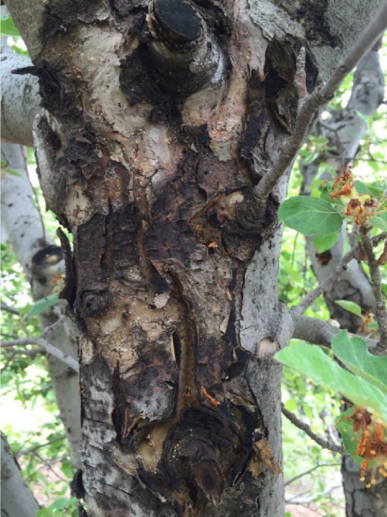Southwest Yard & Garden – Peak Fire Blight Season

The drooping branch with dead leaves on this pear tree is exhibiting classic shepherd’s crook symptoms and was diagnosed with fire blight by the NMSU Plant Diagnostic Clinic.
I’ve got good news and bad news. I’ll give you the good news first. Fire blight, one of the oldest known bacterial plant diseases, only affects plants in the rose family. Celebrate that factoid for a nice long moment. The bad news is that the rose plant family includes lots of common ornamental and fruiting trees and shrubs that we love in New Mexico. According to Phil Lujan, Diagnostician for NMSU’s Plant Diagnostic Clinic, “We are smack in the middle of peak fire blight season and so far we have diagnosed at least 7 positive samples from all around the state with another 5 more pending that just arrived from Bernalillo County.” Lujan added that ornamental pears, followed by edible pears, apples, and photinia are the “usual suspects.”
This week I’ve selected a column on fire blight from July 2018 to reprint with a few updates. The NMSU Plant Diagnostic Clinic (https://aces.nmsu.edu/ces/plantclinic/) analyzes plant material for plant pathogens and environmental stresses and suggests appropriate control measures when available. Insect and weed identification services are also offered. The Plant Diagnostic Clinic is accepting physical samples that are submitted and shipped from your county’s NMSU Cooperative Extension office (https://aces.nmsu.edu/county/).
Question: I think my Asian pear might have fire blight. Can you tell from this branch? – Sample submitted with wilted, blackened leaves at tips of new growth. Jade W., Albuquerque, NM
Answer: I couldn’t tell for sure from the sample, so I sent it to the NMSU Plant Diagnostic Clinic (PDC) in Las Cruces. Former NMSU Extension Plant Pathology Specialist Jason French explained how samples are analyzed in the lab when a bacterial infection is suspected. First, they excise a small amount of tissue at the margin of the infection (the intersection of healthy and symptomatic tissue). Then they macerate and streak the solution onto a specialized media in a petri dish. All of the work is done under sterile conditions. Within 24 to 48 hours, any bacterial growth colonies on the plate are tested further with a metabolite panel.
In the growing season, active infections (like the branch you sampled) should be “removed at least 12–15 inches below the margin of the visible infection because the bacterium moves inside the plant ahead of visible symptom development.” Cleaning your shears or pruning saw blade between every single cut reduces the risk of spreading the disease from tree to tree or even within the same canopy.
Because this bacterium is more likely to infect new growth, remove suckers that sometimes sprout out at the trunk base. That new growth is more susceptible because it’s fast-growing, succulent tissue. “Therefore, avoid heavy applications of nitrogen fertilizers.” (Side note: Other pests, like aphids, also take advantage of tender new growth on plants. By fertilizing your roses less, you may be able to avoid midseason aphid infestations and reduce the need for insecticides.)
Bactericides can be used to reduce infection spread, but proper timing is crucial. For example, treating symptomatic tissue with copper compounds at budbreak in late winter or during bloom time in spring can be effective, but less so later in the season, so routine spraying in the summer is not recommended. Additionally, as fruit are developing, copper compound sprays can cause russetting in fruit, which lowers market value. Russetting doesn’t affect fruit flavor, but the skin gets rough and shelf life can be shortened. After a hailstorm, however, bactericide application can reduce the spread of fire blight on an already infected tree. Always read the product label before use, and remember that just because a product is labeled as “natural” or “organic” doesn’t mean it’s necessarily safe to use without precautions like gloves or a face mask.


Plant tissues infected with fire blight. Photo credits NMSU Plant Diagnostic Clinic.
Fire blight symptoms can be difficult to discern depending on what part of the tree is infected, especially on older plants, and also depending on both the plant and bacterial growth stages. The blackened, drooping leaves and small branches look a lot like tissue hit by a cold snap, but if you see those signs mid-summer, it might be a good idea to grab a sample and submit it to the NMSU Plant Diagnostic Clinic via your NMSU County Extension Office (http://aces.nmsu.edu/county/). Go ahead and get several photos to document the symptoms while you’re at it.
Send gardening questions to Southwest Yard and Garden – Attn: Dr. Marisa Thompson at desertblooms@nmsu.edu, or at the NM Desert Blooms Facebook page (@NMDesertBlooms)
Please copy your County Extension Agent (http://aces.nmsu.edu/county/) and indicate your county of residence when you submit your question!
For more gardening information, visit the NMSU Extension Horticulture page at Desert Blooms (http://desertblooms.nmsu.edu/) and the NMSU Horticulture Publications page at http://aces.nmsu.edu/pubs/_h/.
Marisa Y. Thompson, PhD, is the Extension Horticulture Specialist, in the Department of Extension Plant Sciences at the New Mexico State University Los Lunas Agricultural Science Center, office: 505- 865-7340, ext. 113.
